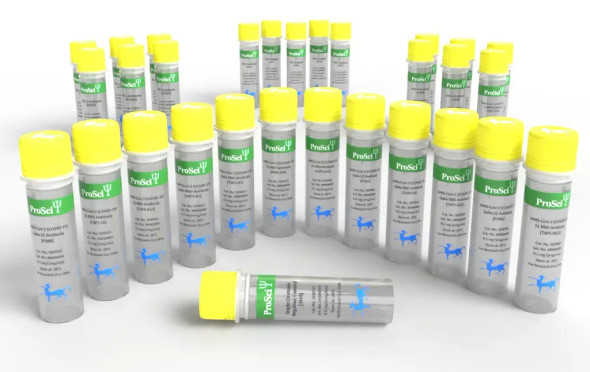Description
PION Antibody | 6161 | ProSci
Host: Rabbit
Reactivity: Human, Mouse, Rat
Homology: N/A
Immunogen: PION antibody was raised against a 19 amino acid synthetic peptide near the carboxy terminus of human PION.
The immunogen is located within amino acids 770 - 820 of PION.
Research Area: Neuroscience
Tested Application: E, WB, IHC-P, IF
Application: PION antibody can be used for detection of PION by Western blot at 0.25 μg/mL. Antibody can also be used for immunohistochemistry starting at 5 μg/mL. For immunofluorescence start at 20 μg/mL.
Antibody validated: Western Blot in mouse samples; Immunohistochemistry in human and mouse samples and Immunofluorescence in human and mouse samples. All other applications and species not yet tested.
Specificiy: Multiple isoforms of PION are known to exist. PION antibody is predicted to not cross-react with other F-box protein family members.
Positive Control 1: Cat. No. 1287 - EL4 Cell Lysate
Positive Control 2: Cat. No. 10-301 - Human Brain Tissue Slide
Positive Control 3: N/A
Positive Control 4: N/A
Positive Control 5: N/A
Positive Control 6: N/A
Molecular Weight: N/A
Validation: N/A
Isoform: N/A
Purification: PION Antibody is affinity chromatography purified via peptide column.
Clonality: Polyclonal
Clone: N/A
Isotype: IgG
Conjugate: Unconjugated
Physical State: Liquid
Buffer: PION Antibody is supplied in PBS containing 0.02% sodium azide.
Concentration: 1 mg/mL
Storage Condition: PION antibody can be stored at 4˚C for three months and -20˚C, stable for up to one year. As with all antibodies care should be taken to avoid repeated freeze thaw cycles. Antibodies should not be exposed to prolonged high temperatures.
Alternate Name: PION Antibody: PION, PION, Gamma-secretase-activating protein, Protein pigeon homolog, GSAP
User Note: Optimal dilutions for each application to be determined by the researcher.
BACKGROUND: PION Antibody: Accumulation of the amyloid-beta peptide (Abeta) in the cerebral cortex is a critical event in the pathogenesis of Alzheimer's disease. The beta-amyloid protein precursor (APP) is cleaved by one of two beta-secretases (BACE and BACE2) , producing a soluble derivative of the protein and a membrane anchored 99 -amino acid carboxy-terminal fragment (C99) . The C99 fragment serves as substrate for gamma-secretase to generate the 4 kDa amyloid-beta peptide (Abeta) , which is deposited in the Alzheimer's disease patient's brains. PION, or GSAP, selectively increases amyloid-beta production through a mechanism involving its interaction with both gamma-secretase and the APP C-terminal fragment, suggesting that PION may be a potential therapeutic target for the treatment of Alzheimer's disease.
Additional Information
Clonality: |
Polyclonal |
Tested Applications: |
E, IF, IHC-P, WB |
Host Species: |
Rabbit |
Species Reactivity: |
Human, Mouse, Rat |
Conjugate: |
Unconjugated |





























